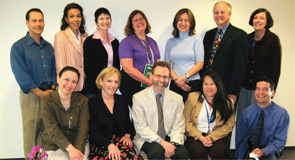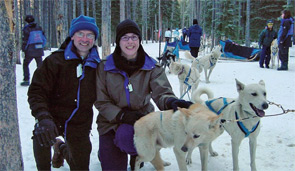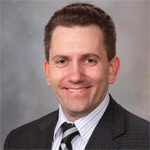
I’ve always been fascinated by the science of immunology, and I wanted to make basic science a part of my career,” reflects Jeffrey N. Siegel, MD, from his office at the Food and Drug Administration (FDA) Center for Drug Evaluation and Research (CDER) in Rockville, Md. “I thought that rheumatology was an area where the new findings from the field of immunology could be translated into clinical therapies for patients. It’s amazing how true that has turned out to be.”
By his conscious choice to work within the government’s regulatory framework, Dr. Siegel has found a way to bring clinical therapies to patients and to serve the FDA’s dual mission to protect and advance the public health. As clinical team leader and supervisory medical office at CDER’s Office of New Drugs, Office of Drug Evaluation II, and Division of Anesthesia, Analgesia, and Rheumatology Products, Dr. Siegel has fostered successful collaborations among clinicians, pharmaceutical companies, and patient advocates to advance the novel treatments now available for rheumatic diseases.
“One of his greatest strengths is that he lent a collaborative atmosphere to working with the drug companies to achieve common goals,” says Daniel E. Furst, MD, the Carl M. Pearson Professor of Rheumatology, Department of Medicine, Division of Rheumatology, at the David Geffen School of Medicine at the University of California, Los Angeles. “Jeff changed the way the FDA is perceived, from a purely adversarial one to a guiding one.”
Conscious Career Choices
Following an internal medicine residency at Case Western Reserve University Hospitals in Cleveland, Dr. Siegel served as a rheumatology fellow there. It was there that Dr. Siegel observed patients’ positive responses to methotrexate therapy, then a new treatment for rheumatoid arthritis (RA). After Case Western, Dr. Siegel moved to the National Institutes of Health in Bethesda, Md., for fellowship training in immunology and molecular biology. He was inspired by lab chief Richard Klausner, MD, and Carl June, MD, head of the immunology group at the Naval Medical Research Institute in Bethesda, Md.
Based on some of the basic science immunology he had been working on—and inspired by Dr. June’s ability to translate basic science ideas into clinical research—Dr. Siegel knew that treatments for rheumatology were in development. He applied to the FDA, and it turned out to be “a perfect time” to join the administration, because cytokine-blocking therapies were just beginning to be studied in RA and other rheumatic diseases. Given early clinical results with Enbrel (etanercept) as one of his first projects as a junior reviewer, Dr. Siegel realized that his hope—that the immunology idea could be translated into clinical therapies—was probably correct. “But I needed to make a decision; I could keep one foot in the basic science laboratory world, or change my direction entirely.”
He chose the latter. When he made his choice to commit to the regulatory world, Dr. Siegel “went back to school,” taking courses in clinical trial design, biostatistics, and reviewer training to prepare for his role. This would, he believed, allow him to apply those ideas to advising companies about clinical development programs in rheumatology.

Problem Solver and Collaborator
“As part of this new thinking about my career, I thought about what I might be able to do to help out in the field of rheumatology to structure a regulatory framework to ensure that drug companies obtained all the information that clinicians need to have,” Dr. Siegel recalls. Indeed, one of Dr. Siegel’s greatest contributions to rheumatology has been the guidance he has furnished to stakeholders as they develop new therapies in the rheumatic diseases.
One of those stakeholders is Joan T. Merrill, MD, medical director of the Lupus Foundation of America in Washington, D.C.; program chair, Clinical Pharmacology Research Program, Oklahoma Medical Research Foundation in Oklahoma City; and professor of medicine, University of Oklahoma Health Sciences Center. “Jeff is an expert in lupus—an incredibly complicated disease—and has innovative ideas about how to design clinical trials,” says Dr. Merrill. “He can help us see pitfalls and/or the advantages to different kinds of trial designs, and he’s really good at explaining those. He is a great person to have at the FDA.”
Alan Tyndall, MBBS, professor and head, University Department of Rheumatology at Felix Platter-Hospital in Basel, Switzerland, first encountered Dr. Siegel during the planning stages for the Autologous Stem cell Transplantation International Scleroderma (ASTIS) Trial. He recalls that he and co-investigator Jaap van Laar, MD, PhD, (now principal investigator) approached Dr. Siegel, who was supportive of their idea to randomize patients to either stem cell transplant or cyclophosphamide, rendering both arms of the trial potentially active. “Dr. Siegel said that our plan made sense because oncology trials do the same: test one principle against another,” Dr. Tyndall says. “Jeff also alerted us to block randomization, in which patients would be grouped in blocks of two, four, or six randomly allocated to either arm. That was a great support to us, since the traditional randomization might have resulted in a center getting all transplants or all control arm treatments—very demotivating for transplant centers.”
Career Timeline
1980 – Earns MD from Yale University School of Medicine in New Haven, Conn.
1981 – Completes internal medicine internship at University Hospitals of Cleveland
1983 – Completes internal medicine residency at University Hospitals of Cleveland
1986 – Completes rheumatology fellowship at University Hospitals of Cleveland
1986 – Joins NIH as medical staff fellow
1987 – Becomes senior staff fellow at NIH
1991 – Becomes branch head, signal transduction, Naval Medical Research Institute
1996 – Becomes medical officer at the FDA
2003 – Becomes supervisory medical officer at the FDA
“On Unpaved Territory”
Dr. Siegel employed his conversance with statistics during the pivotal Early Rheumatic Disease trial of etanercept in the late 1990s. He suggested ways to structure the trials to reduce the risk of bias due to missing data. Previously, trials had as much as one-third missing X-ray data; subsequently, trials had consistently less than one-fifth and sometimes as little as one-tenth missing data. Dr. Siegel also recommended provisions to reduce bias by having readers score films (assign a Sharp Score) in a manner blinded to chronologic order, and then re-sort the films so that the agency could see them in the order they were taken. Barbara Finck, MD, currently chief medical officer of Osprey Pharmaceuticals in San Francisco, was then the lead rheumatologist at Immunex. “Dr. Siegel doesn’t compromise safety,” says Dr. Finck, “but at the same time, he acknowledges that you cannot develop a cutting-edge drug with old technologies or old endpoints. Many times when you’re working in new areas of research, you are on unpaved territory.”
Daniel J. Lovell, MD, MPH, director of rheumatology, and Joseph E. Levinson Professor of Pediatrics, Cincinnati Children’s Hospital Medical Center, has been particularly appreciative of the way in which Dr. Siegel has “led the charge” in pediatric rheumatology since the FDA has applied the 1998 Pediatric Final Rule. “Jeff has been the point person for application of this rule, using their increased authority at the FDA in a way to best serve children. This was a heavy responsibility—if they had been too rigorous about it and too demanding, the bottom line was that companies would not have done studies. If they had been too easy and permissive, then drugs could have potentially been approved without adequate information about efficacy and safety. And the people who have benefited are the kids with arthritis, who now have several approved treatment options.”
Along with his colleague from Cincinnati Children’s Hospital Medical Center, Edward Giannini, MD, Dr. Lovell served with the Pediatric Rheumatology Collaborative Study Group, working with Dr. Siegel on adequate definitions of flare when it came time for the design of pediatric trials for Enbrel. “This was very much a working collaboration of people trying to do the best thing. There wasn’t any posturing, and it was very refreshing, very gratifying, and very effective,” recalls Dr. Lovell.

Working with an FDA biostatistician and other collaborators, Dr. Siegel conceived a novel three-stage clinical trial design to increase the power of the trial in children with juvenile idiopathic arthritis and other orphan diseases. “The idea was to study the same patient multiple times to learn whether the drug works or not,” Dr. Siegel explains. The trial begins as a randomized controlled trial, with half of study participants receiving the test drug and half the placebo. Patients who respond to the drug are then randomized to either drug or placebo; flares would be expected more frequently in the latter group, providing a second, separate way of learning whether the drug was effective. Finally, patients who were originally randomized to placebo would be put on the drug and then randomized to either stay on the drug or be withdrawn. Again, if the latter patients experienced more flares when withdrawn to placebo, this would offer a third way of determining whether the drug worked.
Dr. Finck praises Dr. Siegel’s collaborative stance with industry: “Many times, when you are dealing with the FDA, there are these long silences. Jeff would sometimes just pick up the phone and call us. We would discuss things, and try to find the best path through to the right decision.”
Proactive Ambassador
The titles of Dr. Siegel’s invited talks over the past 10 years speak volumes about his wide-ranging scientific interests and his vision for advancing therapies in the rheumatic diseases. He has given talks on systemic lupus erythematosus (SLE), infections and malignancies in biologics, overviews of the drug development process, regulatory issues in pediatric rheumatology trials, and stem cell transplantation for autoimmune diseases.
Dr. Siegel has also been an active, enthusiastic member of ACR committees. This is atypical for bureaucrats in a regulatory agency, notes Dr. Lovell. “Dr. Siegel has been willing to take on that role, putting himself even more in the public eye.” Dr. Siegel’s participation on the ACR’s Drug Safety Committee has greatly enhanced the relationship between ACR and the FDA, and the ability of the ACR to be a timely and effective source of information about drug safety and efficacy for ACR members, Dr. Lovell says. Dr. Siegel reports that his interactions with the ACR are fulfilling and he looks forward to working with the ACR to develop trial endpoints for conditions such as SLE, dermatomyositis, and scleroderma.
Challenges for the Field
Rheumatologists worldwide have become concerned that noncommercial, investigator-driven trials are declining. “I think the leaders in rheumatology need to send a clear message that clinical research is valuable,” says Dr. Siegel. “They need to work to ensure adequate funding and adequate training to help out with the logistics of conducting clinical trials.” U.S. rheumatologists could learn some valuable approaches from their European colleagues in this regard, he says, pointing to the European League Against Rheumatism (EULAR) system for setting up consensus groups and devising response criteria by employing young rheumatologists in the literature review and initial recommendation process. Dr. Tyndall is also concerned that investigator-driven trials are becoming a “threatened species in the West.” He often touts to his European peers the “Siegel/FDA/ACR model” as an example of breaking through administrative barriers.
Open to the World
Dr. Siegel approaches world travel with the same enthusiasm he brings to his work. Fluent in French, Dr. Siegel also enjoys learning other languages. When he and his wife Dianne go to other countries, he makes it a point to learn basic greetings and conversational phrases and has noticed that people in host countries respond positively to his communicating in their language. Dr. Siegel and his wife also incorporate new activities into their travels. One trip to Canada included a dogsled ride; another to Costa Rica included a zipline tour of the rainforest canopy. “He enjoys new things,” says Dr. Furst. “He enjoys being with and interacting with people. He and his wife are very giving when we’re together.”
Gretchen Henkel is writing the “Metrics in Rheumatology” series.

